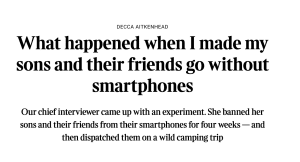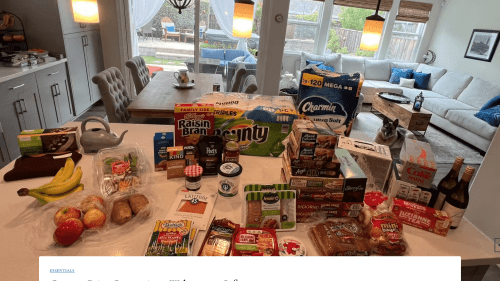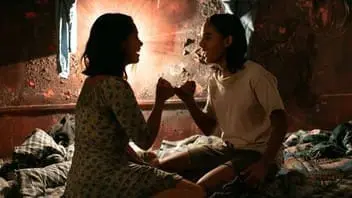And, more importantly, what could go RIGHT?
by Catherine Price, August 21
Last week, I read a story in The Times (of London) that I need to share with you. It’s about how the author—chief interviewer Decca Aitkenhead—convinced her sons and some fellow teenagers to ditch their smartphones for a month and use Light Phones instead. What’s more, she took it a step further and invited the teens to do something truly unusual in this day and age: to go on an unsupervised overnight camping trip together, totally on their own, and without phones.

What happened next should have surprised no one who has ever had an adventure with friends: they had a wonderful time.
But, in reality, there were many surprising things that happened as a result of the experiment that Aitkenhead created for her (thoughtful and beautifully written) piece, and I want to highlight just two of them—in part to help the grown-ups among us better understand just how profoundly teenagers are being affected by social media and smartphones, and in part because it offers an idea for something we all could be doing to generate more fun—for our kids and for us.
Surprising Thing #1: The Kids Wanted to Take a Break from their Phones and Social Media
Okay, that’s not entirely true: the boys in the experiment were initially reluctant to relinquish their smartphones, and Aitkenhead had difficulty recruiting any girls from her sons’ immediate social circles to join in.
But she did eventually recruit two sisters to join in (ages 13 and 15), and when she interviewed them about how they felt social media in particular has affected them, their responses were absolutely heartbreaking: whereas the boys didn’t seem particularly beholden to social media (other than Snapchat), the girls felt entirely controlled by it.
This is an excerpt from a section in which Aitkenhead is addressing the common argument that social media is essentially no different from other technologies that people have gotten worked up about in the past, such as television, and that anyone who thinks differently is stoking “moral panic.”
I ask if Edie and Rose would uninvent [social media] if they could. Both, without hesitation: “Yes.”
Rose’s face fills with dreamy longing. “It would be like Stand By Me, wouldn’t it? I love that film. I’d love that.”
No child I grew up with ever used to dream about uninventing television.
“We did have a childhood,” Edie adds quietly, “without social media. I’m 15 now. Do you want to know why I still sleep with stuffed cuddly toys? To try and get back to how I used to feel, when I felt happy and free. Before all this shit kicked in.”
The article continues:
When I ask why they signed up to the experiment, the girls look surprised.
“Isn’t it obvious? It gives us an excuse. We get to escape this trap for a whole month without looking weird. We can say we’re doing it for The Sunday Times.”
It’s hard to square these comments with the fact that one of the girls’ screen time reports revealed that she had spent 32 hours on social media (just social media!) in the previous week. But they insist that they hate it.
“It’s a trap,” Edie says. “You’re stuck, because if you do escape, you’re classed as a weirdo, and you’ll fall behind on trends, you won’t understand what people are talking about.” Rose jumps in, “But if you do watch TikTok, you’re going to get influenced. You know it’s all fake, but you still feel like it’s real. You still can’t help comparing yourself with everyone who looks pretty, and feeling bad about yourself. And you’re going to get addicted. It’s literally like a drug.”
My Takeaway:
First, I find this heartbreaking, especially because I am the mother of a nine-year-old girl, who is still sleeping with her stuffies and, for the most part, still appears to be happy and free. Why would I ever voluntarily give her a device (i.e. a full-fledged smartphone)—or allow her to join platforms—that would make her feel this way? Part of my job as her parent is to help support her mental health. If it requires me to be the “bad guy,” well, so be it.
Second, I think it’s important for parents to recognize that even though our kids may be furious at us for setting these limits, they might secretly appreciate it. No, they’re probably going to respond to you not getting them a smartphone or forbidding them from being on social media by writing you a thank you note—but I truly do think that, whether it’s now or in ten years, they will be grateful. In fact, by playing the role of the bad guys, we’re doing them a favor: when their friends act like they’re the “weirdos” for not being on social media, they can just blame us.
Surprising Thing #2: The Adults Got in the Way
Remember how I mentioned that part of Aitkenhead’s experiment was to send the kids on an unsupervised camping trip as a way to give them a taste of freedom, independence and — she hoped — fun?
First, to clarify, by “unsupervised camping trip,” she was not talking about sending the kids on a multi-day adventure via Outward Bound. She was talking about having them take a train and a bus to the countryside, walk for two miles on a dirt path, and sleep in a tent in a friend’s garden.
With that in mind, I invite you to enjoy/be horrified by Aitkenhead’s description of what happened when she tried to get clearance from her bosses to incorporate this experiment into her article.
With clueless naivety, I therefore hatch a plan to offer the teens an unsupervised and smartphoneless camping trip in the countryside. The children, by now used to navigating the world without their devices, love this idea. I put the plan to The Sunday Times — and all hell breaks loose.
“It sounds like there is a lot that could go wrong,” a manager emails. A campfire is a “no-no”. Another manager joins the thread. She wants the teens fitted with GPS trackers, and shadowed by a qualified first aider — or, safer still, for me to “find someone whose children have already done this, and interview them” instead. The health and safety team join. “There should be a level of chaperoning.”
What feels like a thousand emails later, they are persuaded that it is not outlandishly dangerous for teenagers to take public transport unaccompanied, walk across some fields and camp in someone’s garden. Parental waivers are submitted, and an exhaustive five-page risk assessment compiled. Having never had to engage with any health and safety bureaucracy before, I’d had no idea this was normal. Now I understand, it feels both miraculous and heroic when the management grants permission for an unsupervised campfire.
I know, right? (And yet, as an American parent, I’m sad to admit that I’m not entirely surprised.)
So what happened when Aitkenhead sent the teens into the wilderness of her friend’s garden, without adults and with access to matches?
They had fun.
As Aitkenhead describes the scene when she shows up at the campsite on Sunday:
At noon on Sunday, campfire embers are still glowing in the heavy drizzle, so there clearly hasn’t been a lot of sleep. Excitable chatter babbles out of the boys’ big family tent. I peer inside to find Dahlia sitting in a large cardboard box, the other five snuggled in sleeping bags, and all wearing expressions that banish my doubts. The mood is electric.
Talking over each other: “Oh my God, so much fun!” “Sooo much fun.” “The fire was amazing. We got a ton of logs from the wood, and we made s’mores, and Isaac and Rose failed to play the guitar.” “We didn’t fail!” Rose is indignant. “I played Radiohead!” What was the best bit of the trip? “All of it.”
She continues:
Sleeping alfresco around the flames, even when the rain set in, made them feel, Lincoln says, “alive. Obviously, it’s horrible feeling cold and wet. But in your normal life, you do the same thing every day. So when you do something different, like sleeping outside, do you understand how great that feels?”
My Takeaway
The article continues—and I recommend that you read it (the kids have some truly poignant observations about how the experiment changed the way they value and interact with their devices and social media)—but the point I wanted to emphasize here is just how simple it is to create opportunities for fun. In short: take away screens, take away adults, and give kids the chance to have an unusual experience on their own.
Did they make some dumb decisions? Yes, yes they did. (Aitkenhead later learns that the boys had discovered that spraying aerosol deodorant into an open flame makes it blaze “like crazy.”)
But were they ultimately okay? Yes. Did they have fun? Definitely. And would it have been as much fun if an adult had been there? Definitely NOT. As Aitkenhead writes,
[By] simply eliminating adults, even something as familiar as camping becomes thrilling. What difference, I ask, would it have made had I taken their Tube, sat in another carriage on the train, and camped nearby in my own tent? Jake looks horrified. “I would have hated it.” Through clenched teeth, “Hated every single second.”“Don’t you see?” says Albie earnestly. “The dream thing for people our age is to go camping and just have fun without parents. The no-adult aspect is literally the dream to us.” They all want to know when they can do it again.
What this means for adults
Well, first of all, it suggests that there’s real value in providing our kids with more opportunities to have screen-free, unsupervised time with friends, scary though that idea may be.
But it also holds a lesson for us adults: the kids clearly tapped into the power of what I call “true fun,” which I define as the confluence of playfulness, connection and flow, and the result was that — in their own words — they felt alive.
If we adults would like to have more fun in our own lives, we can borrow this idea and figure out opportunities to step away from our own screens, recruit some friends, and do something unexpected.
In my book, The Power of Fun, I talk about this in the context of playful rebellion, which was a theme that popped up again and again in people’s stories about fun.
By “rebellion,” I’m not talking about breaking the law; I’m talking about doing something that “breaks the rules” of responsible adulthood, even just a little bit. This rule-breaking could be as simple as consciously deciding to unplug and not be available for a few hours, or sneaking out to a matinee on a workday, or taking a different route home from work.
But it’s even more effective if you go a step further and figure out a way to create a special, shared experience with other people that doesn’t align with your normal daily routine or fit with your usual adult life. For example, I just spent time this weekend playing a game with friends where we tried to catch balls as we jumped off a diving board — we were having so much fun with this “childish” game that the kids started clamoring to join in. (We were at a friend camp weekend that I organized, which itself was a form of “playful rebellion” — and was a ton of fun. More on camps in a future newsletter!)
 |
The last thing I’ll say about this article, which clearly I loved very, very much, is that by giving the teenagers a chance to have a screen-free experience totally on their own, Aitkenhead also gave them the chance to grow and mature—even though it was just one night.
The greatest surprise comes when they dismantle the site. Although sleep-deprived and soggy, they operate like a well-oiled machine, packing my car with precision. All the hapless childish idiocy that worried me when they were planning the trip . . . has vanished. In under 36 unsupervised hours, they appear to have grown up by about two years.
To me this demonstrates the value of giving kids opportunities for independence—but it also suggests that when we don’t give them these small opportunities to try things on their own (and, yes, to do dumb things and make mistakes), we are stunting their development. Which, you know, is not very high on the list of most people’s goals as parents.
In my next post, I’m going to dive in a bit more to how to handle back-to-school screen time, both at home and at school. But for now, I encourage you to go read the article and, bonus points, to recruit some other people to unplug with you and have an adventure together — with or without your kids.
To scrolling less and living more,
“How to Feel Alive”is a newsletter by health and science journalist Catherine Price about how to scroll less and live more in all areas of your life. To see the full “How to Feel Alive” archive (including posts on fun, phones, connection, friendship, parenting, and more), click here. For full access to all posts and perks (and to support my work), please consider becoming a paid subscriber.






